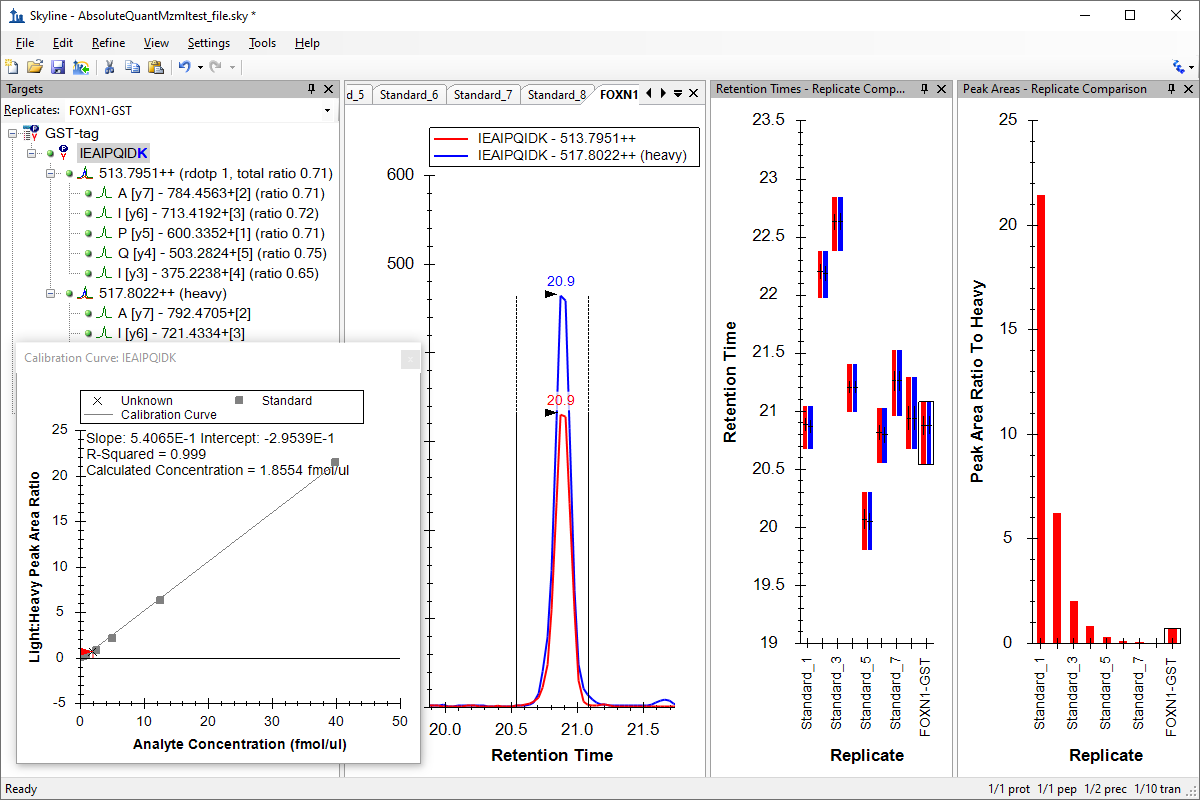Table of Contents |
guest 2025-12-27 |
Questions and Answers
Registration
Webinar #12: Isotope Labeled Standards in Skyline
|
With a highly engaged audience of over 125 in attendance, guest speakers Christina Ludwig and Ariel Bensimon hosted Skyline Tutorial Webinar #12 Isotope Labeled Standards in Skyline on December 1, 2015. After a brief introduction to the Skyline Tutorial Webinar Series and the backgrounds of the two guest speakers by Brendan MacLean (Principal Developer of Skyline), Ariel began the webinar discussing the motivations behind using stable isotope labeling. He then covered how to improve confidence in peptide identification. Christina then covered methods and strategies for improving quantitative precision and accuracy. With virtually all of the audience still in attendance, both hosts took questions for the final 30 minutes of the webinar. Below are the presentations from both speakers. Brendan's introductory and wrap-up slides are included in the slide decks below. If you weren't able to attend the webinar in person, be sure to check out the indexed recording we have posted at the bottom of the page. We got a lot of good questions in the Q&A portion of the webinar -- you'll want to read the answers.
|
Review Webinar 11Panorama Public and Panorama Auto QC Review Webinar 13Calibrated Quantification with Skyline |
Questions and Answers
Q: What's a good dotp value that you would trust?
Ans: The scale of dotp is between 0 and 1. So the closer to 1, the better the dotp. as a rule of thumb, we prefer dotp > 0.9. But one should be very careful with these criteria. Since it is a score of similarity, it relies on the assumption that you expected the spectrum and chromatogram to actually be similar. If a library is generated in conditions which are very different from those in which the samples were later acquired , then you might not get very high dotps, but that shouldn’t undermine the quality of the results. It might simply undermine the assumption that you expect similarity. Be careful, though, the difference can be so great that it starts to make Skyline pick very poor peaks over very nice obvious peaks, because the dotp value is used in the default peak picking. It is definitely safest to know the source of your library spectra, and know they correlate well with your targeted measurements. The score also relates to the number of transitions: If you always compare 20 transitions , or always compare 4 transitions, the range of “good” dotp might change.
As mentioned, when you use heavy labeled standards, you expect very high rdotp (ratio dot-product, similarity between heavy and light), and if this is not the case, you should investigate the reason (usually some kind of interference).
Q: How does Skyline handle the differences in isotope ratios of stable isotope labeled peptides and natural peptides? How is this used during quantitation e.g. absolute quantitation?
Ans: Skyline does allow you to set an "isotope labeling enrichment" in the Transition Settings - Full-Scan tab, but this currently only affects the predicted precursor isotope distributions used during MS1 filtering. The information is not used in absolute quantification, though, certainly isotope labeling enrichment of less than 100% can lead to problems with simple absolute quantification by the assumptions explained in the webinar (slope = 1, intercept = 0), especially when the ratio of light to heavy is very far from 1. Both of the following issues can apply: at very low ratios (e.g. 0.01) much of the measured light peptide could be due to pollution from unlabeled form of the heavy spike-in; the presumed monoisotopic heavy precursor may suffer significant loss due to incomplete labeling enrichment (a favorite example of Mike MacCoss in presentations on quantification). The most thorough solution to these issues is a fully characterized calibration curve, which does not rely on the noted assumptions, and which is also now possible in Skyline. However, in practice, many people still rely on these assumptions, and Skyline does not attempt to apply any special corrections based on the values in the "isotope labeling enrichment" settings. If anyone can cite a study showing that doing so leads to more reliable absolute quantification, we would love to hear about that.
Q: In a SWATH experiment for "biomarker" discovery. Which heavy standards (from which proteins) should i spike in and do you use 1 peptide per protein?
Ans: In a discovery- type experiments, we usually do not spike in standards, since we are trying to discover a protein, which might be a biomarker. So it would be hard to decide which standards to add. If you still want to use heavy and light, I would suggest metabolic labeling or chemical labeling. These try to account for preparative variations (assuming you don't introduce more variation), which would increase your chances of finding a potential protein with biological variation.
When using one peptide per protein, the question is how much do you trust the peptide to reflect the amount of the protein. That can be estimated from data, but cannot be said in advance. It would be recommend to include a few peptides per proteins, in hope that they will conform to the same ratios. Of course, in DIA you can extract as many as possible.
Q: Does pipetting error with heavy peptides introduce more variability?
Ans: Yes. The assumption is that we reduce variability, and not introduce extra variability. You can check it in Skyline, by looking at the CVs of the heavy peptides (in case you always spiked-in the exact same amount of heavy peptide into all analyzed samples).
Q: When it was mentioned Skyline support chemical labeling like TMT, does this include Multinotch-MS3? Is Skyline able to read and analyze raw files where TMT reporter intensities are measured in the MS3 step? If not is this an option that might become available in the near future?
Ans: First it should be noted that Skyline supports only quantification by chromatogram peak areas. In no experiment type, does it support quantifying based on peak intensities from spectra, including reporter ion peak intensities, as is the most common practice in TMT and iTRAQ. A small subset of researchers using TMT and iTRAQ have successfully used Skyline to quantify peptides labeled in this way, using PRM to cause consistent precursor isolation and also consistent reporter ion fragmentation for those precursors over time. The areas under these reporter ion chromatograms, then, can be used for quantification in Skyline. Still, quantification by consistently measured (i.e. PRM) MS3 (multi-notch or otherwise) is not yet supported in Skyline. Nor does it seem high enough priority that it is likely to happen very soon.
Q: Is it acceptable to use only one native (and it's corresponding heavy) peptide to absolutely quantify the abundance of a protein?
Ans: Yes, it is of course possible to quantify a protein (relative or absolute) with just a single peptide and actually there are many papers out there where exactly this has been done. However, when quantifying based on only a single peptide the risk of generating erroneous quantitative data is substantially higher than when performing protein quantification based on several peptides. The chance that the single selected peptide could be an outlier in a sense that it’s a peptide that does not get cleaved from the mother protein completely, that’s not stable over time, that gets posttranslationally modified in certain conditions, etc. is simply higher than when performing protein quantification based on several peptides.
Conclusively, it is highly recommendable to always perform protein quantification based on several (3 to 5) peptides per protein. If protein quantification must get performed based on a single peptide, it is important to make 100% sure that this single peptide really represents the total protein concentration correctly.
Q: How is the peptide content and peptide purity accounted for in case of AQUA or heavy labeled peptide? What kinds of AA needs to be eliminated like M (oxidation) N, Q (deamidation ) in AQUA What AA shouldn' t be present in N-terminus in AQUA Ans:
Ans: Both, crude and AQUA peptides, are prepared at the same isotopic purity. The difference is in the reported amount provided (in fmols for example). For crude peptides, the amount is estimated (and other synthesis products may or may not be present). For AQUA peptides, the peptide is purified, the amount is measured by amino acid analysis (AAA) and reported accurately. In both cases, we have no knowledge about peptide stability. Both crude and AQUA peptides may degrade over time.
For AAs, you indeed need to be careful with AAs prone to chemical modifications, especially with AQUA peptides. There are several criteria for selecting proteotypic quantotypic peptides. You can watch videos of the course online for details. Also you can use online tools such as ThermoFisher’s Peptide Synthesis and Proteotypic Peptide Analyzing Tool.
In the field of targeted proteomics two expressions have been coined for peptides ideally representing a target protein:
- Proteotypic peptides - these are peptides that are unique for a given target protein in a given organism AND these are peptides that show optimal mass spectrometric performance, i.e. these are the best-flyer peptides of a protein
- Quantotypic peptides – these are peptides that also fulfill the criteria of proteotypic peptides, however, they also fulfill a range of additional criteria which make them optimally suited for quantification. These additional criteria include:
- Peptides that do not get chemically modified
- Peptides that do not get posttranslationally modified
- Peptides that do get digested completely
A table that contains important tips and tricks and shows which amino acids or sequences should get avoided when selecting quantotypic peptides is shown below. But be aware: In reality it can get difficult to find MS-detectable peptides that fulfill all of these criteria and consequently people have to relax on some of these criteria in order to end up with measurable data….
|
Selection criteria |
Comments |
|
fully-cleaved |
The peptide should not contain a missed or a non-specific cleavage site according to the applied protease. |
|
unique amino acid sequence in the proteome |
Usually defined based on the genome, but also splice isoforms, single nucleotide polymorphisms or isobaric peptides might be considered. |
|
MS detectability |
Depends on specific physico-chemical properties as well as on the chemical composition of the background (matrix effect). Information about the best peptide detectabilities per protein can be obtained either from empirical data or by using bioinformatic prediction tools. |
|
peptide length |
Ideally in the range of 8 to 25 amino acids. |
|
optimal mass range |
2+ and/or 3+ precursor m/z values should be in the accessible mass range of the used MS instrument. |
|
complete proteolysis |
For trypsin avoid:
|
|
no biological modifications (PTMs) |
Avoid:
|
|
no chemical modifications
|
Avoid:
N-terminal carbamidomethylated C |
Q: I want to create a spectral library for synthetic stable isotope peptide standards. When I follow the tutorial for creating a spectral library, I have to use resources outside of Skyline (Sequest, TPP). This has introduced problems. Can you please integrate these steps into Skyline so that I do not have to go outside of Skyline?
Ans: Thanks for your feedback. We are definitely hearing more and more that people would like Skyline to provide full pipeline integration with a DDA peptide search engine, and obviously several freely available, open source options do exist (Comet, X! Tandem, MSGF+). We will definitely continue to consider our options in this area in our efforts to best server the interests of Skyline users. Again, feedback much appreciated.
Q: For a protein with ~500AA how many peptides need to be monitored for quantification?
Ans: As many as possible, if possible. If you are doing DIA, you may be able to use several peptides. If you are doing PRM/SRM , you may need to select a few representative peptides. We usually measure 3 to 5 peptides per proteins, but you can certainly measure more peptides, or fewer peptides, if you believe these to represent correctly the amount of the protein (see also the answers to similar questions before and after.
Q: How do you account for peptide content and purity? Do you take ratio of 3 peptides for quantification of proteins?
Ans: In relative protein quantification the peptide purity is not taken into account at all. You simply spike-in the same (unknown) peptide amount into all samples that should get relatively compared and perform quantification accordingly, i.e. you assume that the heavy peptide signal in all samples comes from exactly the same peptide concentration.
In absolute protein quantification the peptide purity matters a lot, as here the exact spike-in concentration of the heavy reference peptide must be known. Typically this concentrations gets determined by amino acid analysis, for which a very pure reference peptide (95 to 99% purity) must be available.
As already mentioned in a question above, ideally protein quantification should get performed based on several peptides per protein (3 or more). There are different ways to combine the results of several peptide ratios into a final protein ratio and different people use different options. One frequently used way is to simply average the peptide ratios to a final protein ratio. Other options are to weight peptide ratios depending on the peptide total intensity or the peptide score, or other means.
Q: What amino acids should be avoided for labelled internal standard?
Ans: (See answer to question above) Otherwise, there are no AAs that should be avoided per se, unless you do experiments in which might impair the labeling. For example if you use labeled lysines, but then chemically modify the free amines. In Skyline you can set any type of modification.
Registration
|
Dear Skyline Users, We were happy to have 100 attendees to the Panorama Public and Auto QC webinar. For anyone who would like to review what was presented, we've posted the supporting files. Last week in Barcelona featured another stimulating week-long course on targeted proteomics. If you have not already attended one of these courses, your next opportunity is in the San Francisco Bay Area at The Buck Institute Targeted Proteomics Course. We are very excited to announce our next webinar in the series, featuring two of the original instructors and organizers of these courses: Webinar #12: Isotope Labeled Standards in Skyline [registration closed]
This webinar will include an introduction from Brendan MacLean, Skyline Principal Developer, and presentations and tutorials from proteomic researchers Dr. Christina Ludwig, TU Munich, and Ariel Bensimon, ETH Zurich. Join us, learn and help us to better meet your targeted proteomics research needs. --Skyline Team |
Presenters
Christina Ludwig (Proteomic Researcher) 
Ariel Bensimon (Proteomic Researcher) |
Review Webinar 11Getting the Most Out of DDA Data |


